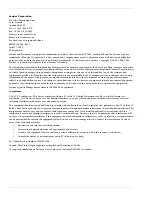
Features
1 - 4 • • • MPS-4100 product guide
Alarm output
Two alarm reporting formats are available for signalling alarm or tamper
conditions. The formats are dry relay contacts and network communications.
For relay contact notification, the MPS-4100 provides jumper-selectable NC/NO
relay outputs for alarm and tamper conditions. The alarm output relay is
energized on power-up and goes into an alarm condition upon loss of DC power.
A NC/NO tamper output is available on both the Receiver and Transmitter.
For network communications there are three options, the Silver Network, the
StarNeT 1000 Alarm Display and Control system, and the MX-5000 Series
Command and Control Center. For the Silver Network and StarNeT 1000, an
optional Communication Interface Card (CIC) provides redundant
communications between the MPS-4100 and the alarm display and control
system. For the MX-5000 Series system, a network transponder enables multiplex
communication over a twisted pair using the proprietary CEnDe protocol. Each
network communication option requires a CIC, which plugs into header P1 on
the Receiver circuit board. Each CIC can handle two microwave zones, enabling
the reporting of an adjacent relay version MPS-4100 system.
Alignment
Accurate alignment of the Transmitter and Receiver, which establishes the
strongest possible signal, is facilitated by a built-in alignment aid. A series of LED’s
on the Receiver circuit board indicate when optimum alignment and maximum
signal strength have been achieved. A 600 ohm impedance audio jack and voltage
test points are also provided on the Receiver card to enable headphones or a
voltmeter to be used as alignment aids.
Audio output
The MPS-4100 Receiver has a built-in audio output that can be used to evaluate
signal variations in the detection path. A tone is generated, which corresponds to
objects moving within the microwave field. The tone varies in frequency and
amplitude according to the disturbance in the microwave field. During quiescent
operation, no tone is generated. As an intruder moves within the protected area,
an audio tone is generated. The tone increases in volume and pitch in relation to
the disturbance of the microwave field. The audio output can be taken to an
amplifier. The Receiver circuit board includes a 3 mm (1/8 in.) audio plug for
connecting a headphone to the local audio output. The local audio output is very
useful in locating the source of nuisance alarms generated by moving objects
within the detection path.
Self-test
The Receiver includes a self-test function to verify proper operation. A 12 VDC
input activates the self-test, which then generates a multi-path signal that
simulates a disruption of the microwave field. The Receiver processes the signal
and generates an alarm.
Содержание MPS-4100
Страница 1: ...Product MPS 4100 Microwave Protection System Guide E6DA0102 003 Rev C Third Edition April 27 2009 ...
Страница 6: ......
Страница 70: ......











































